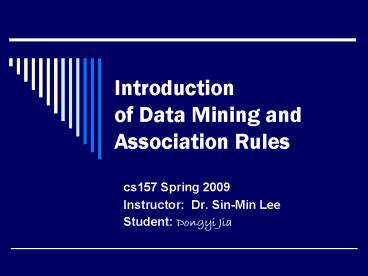Introduction of Data Mining and Association Rules PowerPoint PPT Presentation
1 / 14
Title: Introduction of Data Mining and Association Rules
1
Introduction of Data Mining and Association Rules
- cs157 Spring 2009
- Instructor Dr. Sin-Min Lee
- Student Dongyi Jia
2
What is data mining?
- The automated extraction of hidden predictive
information from database - Allows users to analyze large databases to solve
business decision problems. - An extension of statistics, with a few artificial
intelligence and machine learning twists thrown
in. - Attempts to discover rules and patterns from
data.
3
Data Mining - On What Kind of Data
- In principle, data mining should be applicable to
any kind of information repositiory - ? relational databases
- ? data warehouses
- ? transactional and advanced databases
- ? flat files
- ? World Wide Web
4
Data Mining Functionalities-What kinds of
Patterns Can be Mined?
- Association Analysis
- Classification and Prediction
- Cluster Analysis
- Evolution Analysis
5
Applications of data mining
- Require some sort of Prediction
- for example when a person applies for a
credit card, the credit-card company wants to
predict if the person is a good credit risk. - Looks for Associations
- for example if a customer buys a book, an
on-line bookstore may suggest other associated
books.
6
Associations Rule Discovery
- Task Discovering association rules among items
in a transaction database. - How are association rules mined from large
database? - 1. Find all frequent itemset each of these
itemsets will occur at least as frequent as
pre-determined minimum support count. - 2. Generate strong association rules from the
frequent itemsets these rules must satisfy
minimum support and minimum confidence.
7
Association Rules (cont.)
- Retail shops are often interested in associations
between items that people buy. - Someone who buys bread is quite likely also to
buy milk. - association rule bread gt milk
- A person who brought the book Database System
Concepts is quite likely also to buy the book
Operating System Concepts. - association rule DSC gt OSC
8
Association Rules (cont.)
- Two numbers
- Support is a measure of what fraction of the
population satisfies both the antecedent and the
consequent of the true. - Confidence is a measure of how often the
consequent is true when the antecedent is true.
9
Association Rules (cont.)
- Let I i1, i2, im be a total set of items
- D is a set of transactions
- d is one transaction consists of a set
of items - d ? I
- Association rule
- X ? Y where X ? I ,Y ? I and X ? Y ?
- support (of transactions contain X ? Y ) /D
- confidence (of transactions contain X ? Y ) /
- of transactions contain X
10
example
- Example of transaction data
- CD player, musics CD, musics book
- CD player, musics CD
- musics CD, musics book
- CD player
- I CD player, musics CD, musics book
- D 4
- of transactions contain both CD player, musics
CD 2 - of transactions contain CD player 3
- CD player ? musics CD (sup2/4 , conf 2/3 )
11
Association Rules (cont.)
- Rule support and confidence reflect the
usefulness and certainty of discovered rules. - A support of 50 for association rule means that
50 of all the transactions under analysis that
CDs player and music CD are purchased together. - A confidence of 67 means that 67 of the
customers who purchased a CDs player also bought
music CD.
12
Strong Association Rule
- User sets support and confidence thresholds.
- Rules above support threshold have LARGE support.
- Rules above confidence threshold have HIGH
confidence. - Rules satisfying both are said to be STRONG.
13
References
- Professor Lees lectures
- http//www.cs.sjsu.edu/lee/cs157b/cs157b.html
- Rui Zhao, SJSU
- http//www.cs.sjsu.edu/lee/cs157b/cs157b.html
- Jiawei Han, Micheline Kamber
- Data Mining Concepts and Techniques
- Morgan Kaufmann Publishers
14
Thank you !

